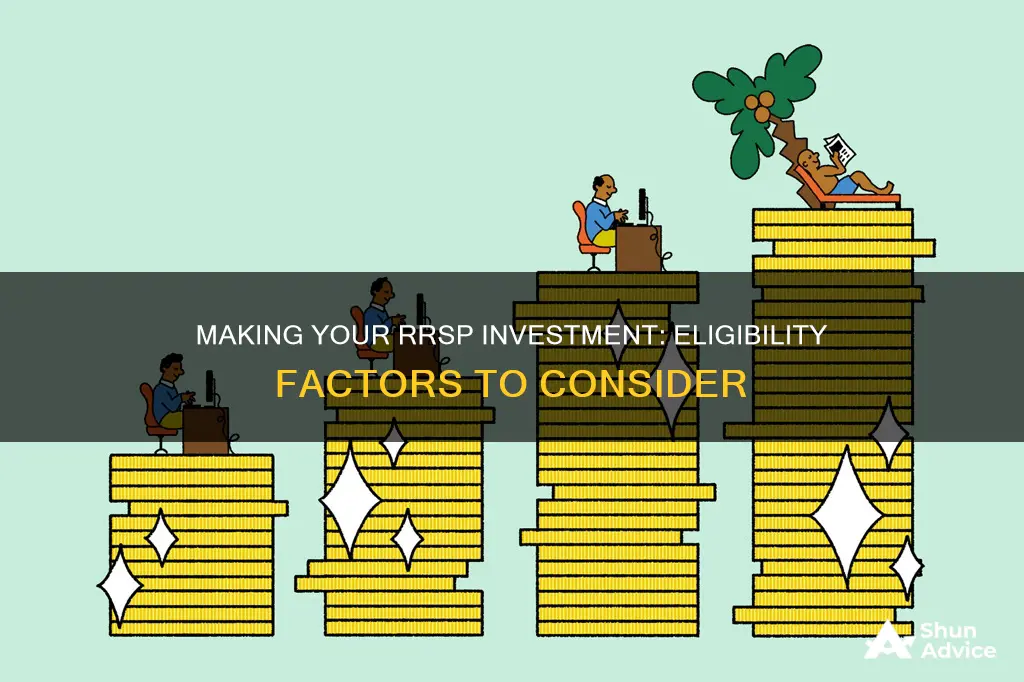
A Registered Retirement Savings Plan (RRSP) is a savings plan that allows Canadians to save for retirement while offering tax advantages. RRSPs are registered with the Canadian government and offer tax-deferred investment growth. Contributions to an RRSP are tax-deductible and investment earnings within the RRSP are not taxed until withdrawal. There are different types of RRSPs, including individual, spousal, and group plans. To be eligible for an RRSP, one must be a Canadian resident with a Social Insurance Number, earned income, and file a tax return. It is important to understand the rules and contribution limits to maximize the benefits of an RRSP and avoid tax penalties.
| Characteristics | Values |
|---|---|
| Type of account | Registered Retirement Savings Plan (RRSP) |
| Tax status | Tax-deductible contributions and tax-deferred investment growth |
| Investment types | Cash, gold, GICs, bonds, mutual funds, ETFs, stocks, options, savings deposits, and more |
| Ineligible investments | Precious metals, personal assets, employee stock options, mortgage loans on commercial properties owned by related persons, investments in small businesses, and more |
| Purpose | Retirement savings |
| Additional uses | Down payment on a home, funding educational costs |
| Contribution limit | 18% of previous year's earned income or $31,560 in 2024, whichever is lower |
| Age limit | Must close the account by the end of the year an account holder turns 71 |
What You'll Learn
- Eligible investments include savings, cash, stocks, bonds, and mutual funds
- Ineligible investments include precious metals, personal assets, and employee stock options
- You can open an RRSP at a bank, credit union, investment firm, or life insurance company
- RRSPs offer tax advantages, including tax-deductible contributions and tax-deferred investment growth
- You can borrow from your RRSP to buy a home or pay for education under certain programs

Eligible investments include savings, cash, stocks, bonds, and mutual funds
Eligible investments for a Registered Retirement Savings Plan (RRSP) include savings, cash, stocks, bonds, and mutual funds. RRSPs are a key part of retirement planning because of the tax advantages they offer. RRSPs allow your savings for retirement to grow tax-deferred in a special plan registered with the Canadian government.
RRSPs can hold savings deposits and investments. Qualified investments allowed to be held in an RRSP include cash, gold, guaranteed investment certificates (GICs), bonds, mutual funds, exchange-traded funds (ETFs), and more.
You can open an RRSP at any age as long as you have earned income and file a tax return. You must close your RRSP when you turn 71.
RRSPs can be opened at:
- Banks and trust companies
- Credit unions and caisses populaires
- Mutual fund companies
- Investment firms (for self-directed RRSPs)
- Life insurance companies
Roth Retirement Accounts: Smart Investment or Waste of Money?
You may want to see also

Ineligible investments include precious metals, personal assets, and employee stock options
When it comes to making an investment RRSP-eligible, it's important to know that not all investments are eligible to be held in an RRSP. Ineligible investments include precious metals, personal assets, and employee stock options.
Precious metals such as gold, silver, and other similar metals are not eligible for inclusion in an RRSP. This means that investors cannot hold these metals directly within their RRSPs. However, it's worth noting that some gold or silver mining stocks may be eligible, as long as they are not prohibited investments due to close ties with the investor.
Personal assets, such as jewellery, art, antiques, and similar items, are also not eligible for inclusion in an RRSP. These tangible assets are considered personal property and are therefore not suitable for RRSP investment purposes.
Additionally, employee stock options are not eligible for RRSP investment. Stock options granted by an employer as part of a compensation package cannot be held in an RRSP. This restriction is in place to prevent individuals from using their RRSPs for tax-sheltered investing in their employer's business.
It is important to be aware of these ineligible investments to avoid potential penalties. Holding prohibited investments in an RRSP can result in consequences, including a special tax of up to 50% of the fair market value of the prohibited investment. This tax is calculated from the purchase date or the date the investment became prohibited. Therefore, it is advisable to consult a financial advisor to ensure compliance with RRSP investment regulations.
Savings Strategies: Investing for Your Down Payment
You may want to see also

You can open an RRSP at a bank, credit union, investment firm, or life insurance company
You can open a Registered Retirement Savings Plan (RRSP) account at a variety of financial institutions, including banks, credit unions, trusts, or insurance companies. Here is a step-by-step guide on how to open an RRSP account:
- Visit the institution's website and locate their RRSP account opening page.
- Complete the online application form, providing your personal information, such as your name, address, date of birth, social insurance number, contact details, and employment information.
- Review and accept the terms and conditions of the account.
- Choose your desired funding method, such as an electronic funds transfer from a linked bank account or depositing funds in person.
- Provide a digital copy of your government-issued ID (e.g., driver's license or passport) for verification.
- Submit your application and await confirmation.
It is important to note that some institutions might charge a small setup fee for opening an RRSP account. Additionally, you must meet specific criteria as defined by the Government of Canada to be eligible for an RRSP. These criteria include residency, age, and income requirements.
Once you have opened your RRSP account, you can start investing in eligible investments such as guaranteed investment certificates (GICs), exchange-traded funds (ETFs), and mutual funds. It is recommended to diversify your portfolio and periodically rebalance your asset distribution to match your risk tolerance and life changes.
Retirement Corpus Investment Guide for Indians
You may want to see also

RRSPs offer tax advantages, including tax-deductible contributions and tax-deferred investment growth
A Registered Retirement Savings Plan (RRSP) is a savings plan that helps you save for retirement. RRSPs offer tax advantages, including tax-deductible contributions and tax-deferred investment growth.
RRSPs are registered with the Canadian federal government, and contributions are "tax-advantaged", meaning they are exempt from being taxed in the year you make them. This means that your RRSP contributions reduce your taxable income, which can result in a lower tax bill or a larger refund. Essentially, your contributions are made with pre-tax dollars.
Any investment income earned from investments held within the RRSP can grow tax-deferred as long as the money remains in the RRSP. This means that any interest or investment earnings made from the money in your RRSP is not taxed until you withdraw it. By the time you retire and withdraw the money, you may be in a lower tax bracket, resulting in a lower tax rate on your withdrawals.
There are several types of investments that can be held in an RRSP, including stocks, bonds, mutual funds, exchange-traded funds (ETFs), and guaranteed investment certificates (GICs). It's important to note that there are also ineligible investments for RRSPs, such as personal assets, precious metals, employee stock options, and investments in private companies where you are a designated shareholder.
RRSPs offer a range of tax advantages, including tax-deductible contributions and tax-deferred investment growth, making them a popular choice for Canadians looking to save for retirement while minimizing their tax burden.
Investment Bankers' Salary: How Much Do They Earn?
You may want to see also

You can borrow from your RRSP to buy a home or pay for education under certain programs
The Home Buyers' Plan (HBP) is a federal program that allows you to borrow from your RRSP to buy a home. The HBP is designed to help first-time buyers afford the upfront costs of buying a home, such as the down payment and closing costs. To be eligible for the HBP, you must be a Canadian resident, a first-time homebuyer, or not have owned a home in the last four to five years. You must also have a written agreement to buy or build a qualifying home and intend to live in the home as your primary residence within a year of buying or building it.
The HBP withdrawal limit is currently $60,000 per person ($120,000 for a couple) and can be used to finance the purchase or construction of a home. You can also use the HBP if you are separated or divorced, even if you do not meet the first-time homebuyer requirement, as long as you have lived separate and apart from your spouse or common-law partner for at least 90 days due to a breakdown in your relationship. It's important to note that you will need to repay the borrowed amount over a 15-year period, starting the second year after the withdrawal. The minimum amount due each year is 1/15th of the total amount withdrawn.
Additionally, the Lifelong Learning Plan (LLP) allows you to borrow from your RRSP to pay for education costs for yourself or your spouse. Under the LLP, you can withdraw up to $20,000, which must be repaid within a specified time frame to avoid tax penalties.
Invest Wisely for Your Child's Education in India
You may want to see also
Frequently asked questions
A Registered Retirement Savings Plan (RRSP) is a savings plan that allows your savings for retirement to grow tax-deferred. It is registered with the Canadian government and offers tax advantages.
RRSPs offer several benefits, including tax-deductible contributions, tax-deferred investment growth, and income-splitting opportunities. Contributions reduce your taxable income, and investment earnings are not taxed until withdrawal, typically during retirement when your tax rate may be lower.
Eligible investments for an RRSP include guaranteed investment certificates (GICs), mutual funds, exchange-traded funds (ETFs), stocks, bonds, and cash. These investments must be qualified and cannot include personal assets, precious metals, or certain types of bonds.
You can open an RRSP at various financial institutions, including banks, credit unions, mutual fund companies, and investment firms. Most Canadians who are Canadian residents with a Social Insurance Number (SIN), have earned income, and file a tax return are eligible to open an RRSP.







